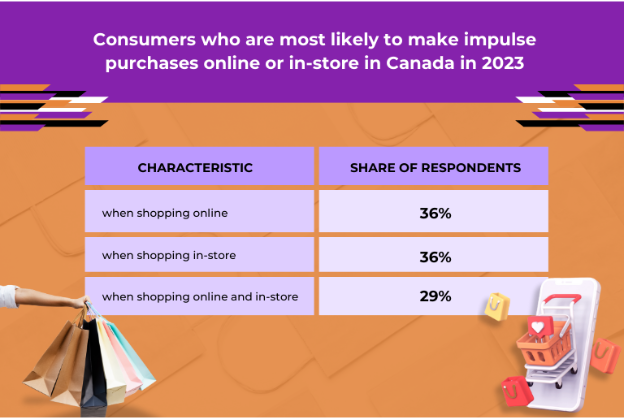According to Statista,
29% of buyers are most likely making impulse purchases while shopping online or in-store.
The good thing is, by building healthy financial habits, you can say goodbye to buyer's remorse and hello to a more secure financial future. This article empowers you to break free from the impulse-buying trap.
Here are 10 practical strategies to help you make conscious spending decisions and achieve your financial goals.
1. Identify Your Triggers
Here are some common triggers to watch out for:
Retail therapy might seem like a temporary escape, but the financial burden it creates can amplify stress in the long run. Consider healthier coping mechanisms like exercise, meditation, or spending time with loved ones.
Shopping can feel like a fun activity, even if it leads to unnecessary purchases. Find free or low-cost ways to fill your time, such as reading, volunteering, or exploring nature.
Don't fall prey to the highlight reel on social media. Remember, people often showcase their best purchases, not their financial struggles. Focus on your own financial journey and avoid comparing yourself to others.
- Fear of Missing Out (FOMO)
Limited-time sales and marketing tactics that create a sense of urgency can trigger impulse buying. Remember, there will always be another sale or promotion. Train yourself to be a discerning consumer, not a impulsive buyer.
2. Learn to Say "No"
Once you identify your triggers, it's time to establish boundaries. Here are ways to strengthen your "no" muscle when faced with an impulse purchase:
Implement a waiting period before buying anything non-essential. Sleep on it, and see if the desire persists. Often, the initial excitement fades, and you realize the purchase wasn't truly necessary.
- The "Needs vs. Wants" Audit
Before adding anything to your cart, ask yourself this crucial question: Is this a need or a want? Prioritize needs like groceries, rent, and utilities. Wants can wait, especially if you don't have the budget for them.
- The "Cost Per Use" Analysis
For items you genuinely want, consider the cost per use. Will this be a one-time wear garment, or will you get multiple uses out of it? This helps you assess the long-term value of the purchase.
3. Craft a Budget and Stick to It: Taking Control of Your Finances
The foundation of healthy spending habits is a well-defined budget. Track your income and expenses to identify areas where you can cut back. Here are some budgeting tools and strategies:
Allocate 50% of your income to needs, 30% to wants, and 20% to savings and debt repayment.
This framework provides a good starting point for budgeting.
Leverage technology to simplify budgeting. There are numerous budget apps available that allow you to track your expenses categorize spending, and set savings goals.
4. Plan Your Shopping Trips and Avoid Temptation
Spontaneous trips to the mall or aimlessly browsing online are prime breeding grounds for impulse buying. Here are ways to plan your shopping trips for success:
Before heading to the store, create a comprehensive list of items you actually need. Stick to this list and avoid wandering into aisles that tempt you to deviate from your plan.
Hunger pangs can lead to impulsive food purchases. Eat a healthy meal before shopping to avoid succumbing to temptation.
- Unsubscribe from Tempting Emails
Unsubscribe from marketing emails that bombard you with deals and promotions. This reduces the constant barrage of temptation.
5. Embrace the Power of "Cash Only"
Credit cards offer convenience, but they can also make it easy to overspend. Consider using cash for most of your purchases. This physical reminder of your spending limits can help you make more conscious decisions.
6. Set Clear Financial Goals
Having tangible financial goals can shift your focus from immediate gratification to long-term rewards. Here are some ways to make saving exciting:
Create a vision board or a savings jar to visualize your financial goals. This will keep you motivated and focused on your long-term aspirations.
- Reward Yourself for Progress
Celebrate your saving milestones with small rewards, such as a favorite meal, a new book, or a day trip. This positive reinforcement can make saving enjoyable.
Use a savings tracker or app to monitor your progress towards your financial goals. This visual representation of your growing savings can be incredibly motivating.
7. Minimize Possessions, Maximize Happiness
Research shows that material possessions don't necessarily translate to happiness.
Researchers, Amy Isham et. al, have found that “materialistic values were negatively associated with sufficiency attitudes, mindfulness, and flow experiences”
Decluttering your belongings can help you appreciate what you already have and reduce the urge to acquire more.
Apply the KonMari method to declutter your possessions by asking yourself, "Does this spark joy?" If not, let it go.
Before buying something, ask yourself if it aligns with your values and contributes to your overall well-being. This mindful approach can help you resist unnecessary purchases.
8. Find Alternatives to Retail Therapy
Impulse buying can be a coping mechanism for stress or boredom. Explore healthier ways to manage your emotions and find joy in life:
Physical activity is a great way to reduce stress and improve your mood. Regular exercise can also help you stay healthy and save money on medical expenses.
Enroll in a class, take up a hobby, or explore a new skill. Learning something new can be intellectually stimulating and prevent boredom-induced shopping.
Spend time with loved ones, volunteer in your community, or join social clubs. Building strong relationships can provide emotional support and fulfillment.
9. Seek Support and Accountability
Breaking free from impulse buying habits can be challenging, but you don't have to do it alone. Surround yourself with a support system that encourages and holds you accountable:
Let friends and family know about your commitment to curb impulse buying. Their support can be a powerful motivator.
Look for online or in-person support groups that focus on financial wellness. Sharing your experiences with others can provide comfort and accountability.
- Consider Professional Help
If you struggle with compulsive spending, a financial therapist or counsellor can provide guidance and tools to break the cycle.
10. Appreciate What You Have
Cultivating a mindset of gratitude can help you appreciate what you already have and reduce the desire for more. Mindfulness practices like meditation or deep breathing can also help you stay present and make more conscious spending decisions.







